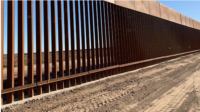In a rush to build more than 450 miles of barrier on the U.S.-Mexico border by the end of 2020, the U.S. Army Corps of Engineers expedited construction using a contracting approach that boosted the risk of higher project costs, the U.S. Government Accountability Office says in a new report.
To accelerate construction after former President Donald Trump's "border emergency'" order in 2019, the Corps took advantage of various authorities to start quickly, including awarding work "without full and open competition and authorizing contractors to begin work before defining key requirements,” GAO says.
The federal watchdog agency analyzed 39 construction contracts valued at $10.6 billion that were awarded between October 2017 and September 2020 using both U.S. Defense Dept. and Homeland Security Dept. funding.
Some DOD funding was only available for a short period before expiring, giving the Corps a tight schedule for contract awards that led it to depart from a planned acquisition approach, according to GAO.
The Corps had plans to award $11 billion in border construction contracts over five years. But about $9 billion worth was awarded after the Trump order, leading to the $10.6-billion total by September 2020.
The Corps awarded $4.3 billion in noncompetitive contracts and structured many awards to make sure that bollard wall panels were installed in the ground rather than requiring a full barrier system that included certain technology and electric components to be completed, the report says. Overall, by the end of 2020, there were about 69 miles of completed wall systems, GAO says.
According to Corps and Homeland Security Dept. statistics released in January, of the 453 miles of walls constructed, 351 miles were replacement structures, 55 miles were “secondary” structures and only 47 miles were new barriers where none had existed.
The Corps awarded four non-compete contracts it termed “undefinitized contract actions,” which allow contractors to begin work while the scope, terms and price are being negotiated. Completing negotiations before the awards would not have allowed contractors to meet the agency's 18-month delivery schedule, according to GAO.
Use of such contracts is risky because “contractors have little incentive to control costs,” GAO says.
The contracts at issue had a defined value of $2.5 billion, but ultimately cost $4.3 billion. Under one contract, the Corps determined that while the contractor’s profit rate was 2.5% higher than the rate calculated based on regulations and guidance, it was fair given the wall panel delivery deadline of Dec. 31, 2020, GAO says it was told by a Corps official.
About 88% of border wall contracts issued from 2018 to 2020 were awarded to four contractors, with Southwest Valley Constructors, a Kiewit subsidiary; receiving 26% of the total; SLSCO Ltd. and Fisher Sand and Gravel each receiving 21%; and BFBC, a Barnard Construction unit, awarded 19%. Ten other companies were awarded the remaining 12%.
The Corps waived multiple environmental protection requirements to expedite the award of two of the non-compete contracts based on the Secretary of Defense’s direction to begin construction expeditiously “without regard to provisions of law,” GAO says. Six other contracts reviewed by the watchdog also had environmental and real estate laws waived.
As of February 2019, the Corps no longer required contractors to submit cost proposals when competing for projects under indefinite delivery-indefinite quantity contracts, as long as proposals were technically acceptable.
GAO recommended that the Corps reassess its acquisition strategy going forward. The Corps concurred with the recommendation and plans to conduct an after-action review to identify other approaches to respond to a national emergency.
Robert Miceli, the Corps' deputy director of contracting, and Army Brig. Gen. Richard Heitkamp, deputy commander, told GAO that the agency “is considering" added emergency response contract mechanisms for “unpredictable" and "largely undefined" emergencies that "are more difficult to preposition contracts with the capacity and expertise needed to be responsive.”
The White House released a plan on June 11 to use unspent DOD border wall funds to repair damage caused by barrier construction and return the rest, about $2 billion, to the military for originally intended construction projects. The Biden administration also will ask Congress to cancel remaining Homeland Security Dept. funds for wall construction and use the money for more effective border management such as improving infrastructure at entry points between Mexico and the U.S. and the addition of enhanced technology.
About 100 environmental groups have asked heads of congressional appropriations committees for funding in next year's federal budget to mitigate wall construction damage.
In a June 15 ruling, GAO said that the administration’s decision to halt border wall construction using Homeland Security funds appropriated by Congress to alter project scope in order to mitigate environmental damage and minimize effects on border communities is not illegal. “Delays in spending these funds in order to satisfy applicable statutory requirements are programmatic delays, not impoundments,” the agency said.
Texas Republican Gov. Greg Abbott said he has committed $250 million from the state's budget to launch a state-run border wall construction program and directed the Texas Facilities Commission on June 18 to hire a program management firm to determine location and cost.
The effort also may involve private donations of funding and land that Abbott contends could allow construction of hundreds of miles of border wall.





